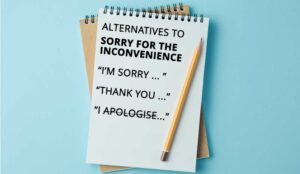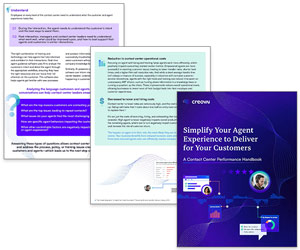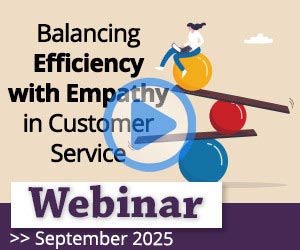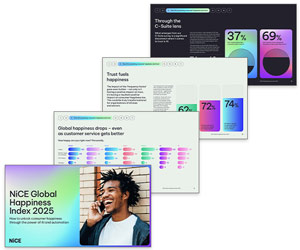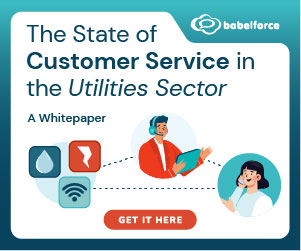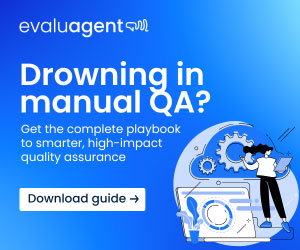“Sorry” can quickly lose its true meaning and even frustrate customers when not delivered correctly.
To put the spotlight on just how wrong things can go, we asked our consultants panel for their worst examples of missing the mark when saying “sorry” to customers.
When Good Intentions Do More Harm Than Good…
Asking the Customer: “How Would You Like Us to Fix This for You?”

One of the worst mistakes you can make is asking the customer: “How would you like us to fix this for you?” I get it. You’ve got good intentions in asking this question. You think you’re giving the customer the benefit of “owning” the solution.
But the customer doesn’t see it that way. To them, at best, this question feels lazy. At worst, it feels like emotional outsourcing – like you’re putting the burden of resolution back on them when they’re already exhausted and frustrated.
You broke it (or at least your brand did). Customers shouldn’t have to build the repair plan. They shouldn’t have to do your job!
In apology moments, customers are upset, confused, or anxious. They don’t know what’s possible. They don’t want to negotiate. They want things made right. They want to feel heard, helped, and valued.
When you ask them how to fix it, you increase their cognitive load and drive their anxiety even further. Instead of solving the problem, you just added another one.
So, here’s the better play: Own the situation. Take the lead. Be specific about how you will make it right. It’s as simple as saying, “This is what we can do to help you.”
Contributed by: Matt Lyles, Keynote Speaker, Brand Consultant and Podcast Host
Leading the Conversation With Empty Empathy and Overused Phrases
Empty empathy is not bad intent, it is bad communication. What is missing is ownership and authenticity.
A true professional does not hide behind polite phrases. They lean in, listen deeply, and respond with purpose.
Let’s look at the difference here:
- Weak Response – “I understand how you feel.” What the customer hears: “I’ve been trained to say this, not to help you.”
- Strong Response – “I understand how you feel. You mentioned your most recent bill was confusing, and I know how frustrating that can be. The good news is, I am part of the billing team and I deal with these issues daily. Let me break it down for you.”
That is not just empathy, it’s advocacy. It tells the customer: I have heard you, I have got this, and I am here to help.
Contributed by: Jon Edwards, Managing Director at The Lion Consultancy Ltd.
For practical, proven techniques that contact centres can adopt to enhance empathy over the phone, read our article: 26 Great Techniques for Showing Real Empathy in Customer Service
When Agents Misuse the Words “I’m Sorry…”
Saying “I’m Sorry You Feel That Way…”

A little while ago I received what I can only describe as the bare minimum of human remorse from a contact centre.
I’d ordered a birthday gift for my wife and it didn’t arrive. No update. No explanation. So, I called customer service.
After I finally got through to a human, I was told “I’m sorry you feel that way. Once it leaves our warehouse, it’s out of our hands. You’ll need to wait another 5 to 7 business days. Thank you for your patience”.
So, let’s look closer at that line…
- “I’m sorry you feel that way” – This subtly shifts the focus away from the issue (delayed delivery) and onto my feelings, implying that my reaction – not their service – is the real problem. It’s like saying, “I’m sorry you’re so sensitive”, or “I’m sorry you get offended so easily”
- “Once it leaves our warehouse, it’s out of our hands” – This tells me that we’re done here. It communicates that the company has no control, no recourse, and frankly, no interest in trying to help me. This annoyed me even more – I didn’t buy it from the delivery company… I bought it from you. And I didn’t choose the delivery company – that was also you!
- “You’ll need to wait another 5 to 7 business days” – What now? I’ll ask my wife to go back in time and delay her birth, huh? Unfortunately, this part might actually be accurate, but it’s delivered to me with no warmth or effort to reassure me. No empathy, no offer to check or follow up, just a timeframe. And basically, a feeling that I needed to either ‘like’ it, or ‘lump’ it.
- And finally, no solution.
So how should this have been dealt with? Well, here’s what I would have said:
“I’m so sorry your gift hasn’t arrived – I know how frustrating that must be, especially with a birthday on the line. Let me take a closer look and see what I can do to get this sorted quickly. Even if it’s out for delivery, I’ll follow up on our end and keep you posted.”
An apology doesn’t need to be perfect – it just needs to sound like a human who cares.
Contributed by: Dara Kiernan, Leadership Development and Contact Centre Consultant
Spurting “The Passive-Aggressive Sorry”

Let’s face it: a bad apology can definitely make things worse. Whether it’s the tone, the wording, or the attitude behind it, there are plenty of ways to get it wrong.
And when apologies go wrong, customers remember it. In fact, they may remember even more than the reason why you are apologizing.
Passive-aggressive is probably the worst – better not apologize at all. As this approach is more about shutting down a conversation and opening doors for a conflictual situation than resolving the issue.
The solution? Show care and understanding at all times. For example, “I both acknowledge and understand how disappointed you are, and I am willing to help you make this right.”
A real apology doesn’t just smooth things over – it rebuilds trust, loyalty, and sometimes even turns a bad moment into your best customer success story.
Contributed by: Pierre Bauzee, Founder of Beyond Satisfaction
If you want tips to make sure your apologies are sincere, read our article: Customer Service Apologies – Keeping Sorry Fresh and Sincere
Using the Word “But…” Immediately After Saying “Sorry”

Avoid using “but”, as this can sound like you are dismissing the customer’s feelings. For example, “I can tell you are frustrated, BUT I want to help” may make the customer even more upset.
A better approach is to acknowledge the customer’s feelings, use “AND” to connect, and offer to help. For example: “I can tell you are frustrated, AND I want to help.” Using “AND” keeps the conversation positive and supportive.
[Did you know? In some jurisdictions, especially in parts of the US, saying “sorry” can be viewed as a legal admission of guilt? In those cases, it is safer to avoid saying “I’m sorry” altogether.]
Contributed by: Mike Aoki, President of Reflective Keynotes Inc.
Overusing the Words “I’m Sorry…” in the Same Conversation

How many times are your agents saying “I’m sorry” in the same conversation?
It’s fine to start out with “I’m so sorry this has happened”, but if they continue to say, “I’m sorry”, “I’m sorry”, “I’m sorry” throughout the conversation, it has a similar effect to overusing someone’s name and quickly starts to sound insincere.
Yes, you do need to acknowledge the problem and give an apology, but then follow up with how to fix it. For example, “I’m sorry this happened. Let’s talk about getting this resolved.”
Then progress to the resolution as quickly as possible. Customers don’t want to hear your agents say “it will take us five–seven days to get back to you” either!
Contributed by: Shep Hyken, Chief Amazement Officer (CAO) at Shepard Presentations LLC
Only Saying “Sorry” to Check the Box in the QA Process
I think that agents sometimes feel that they HAVE to say it to ‘game’ the system… Somewhere it is embedded in their QA scoring process, so they tick the box and move on!
So, whilst it may be the agent who delivers the ‘bad sorry’, it is worth considering the metrics, leadership and culture that makes them feel like they have no choice.
Contributed by: Nathan Dring, Founder and Director of Nathan Dring and Associates Limited
For advice for avoiding awful apology statements and turning “sorry” into lifelong loyalty, read our article: “Sorry for the Inconvenience” – How to Offer a Genuine Apology
When the Blame Is on the Customer – Not the Underlying Issue…
“If You Have No Intention of Changing the Policy, You’re Not Really Sorry!”

The biggest fail has to be saying sorry for policy. If you’re really sorry, you’ll change your policy. If you have no intention of changing policy, you’re not really sorry!
A genuine apology ultimately comes down to understanding the impact on the customer. There’s enormous power in saying “We’ve noticed X happened earlier today, we’ve done Y about it, so it won’t happen again and are giving you Z to make up for the inconvenience.”
If a customer has been impacted but you’ve failed to run the right root cause analysis, the worst case scenario is the same customer falls victim to the same impact again – then no apology, however genuine it is, will win that customer back.
Contributed by: Mark Allaway, Evosa
Shifting the Blame to the Customer With “Unfortunately, You’ve…”

“If you’d checked the small print…”, “Unfortunately, you selected the wrong option…”
Even if the customer was at fault, saying it like this is guaranteed to wind them up.
- Why it fails – Nobody wants to be blamed when they’re already frustrated. It’s dismissive and defensive – and it kills any chance of resolution.
- Do better – Find common ground. Say things like, “I can see how that would be frustrating” or “Let me look into this and see what we can do”. Take ownership where possible, and focus on moving forward, not pointing fingers.
Hiding Behind Policies and Saying “There’s Nothing I Can Do…”
“That’s just our policy…”, “There’s nothing I can do, I’m afraid…”
- Why it fails – It signals to the customer that processes matter more than people. It’s not only frustrating, but also lazy.
- Do better – Review your frontline scripts and escalation processes. Ask yourself: are they helping your team solve problems or just giving them a shield to hide behind? Customers want solutions, not policy quotes.
Contributed by: Dan Pratt, Founder & Director of DAP Consultancy
When You Don’t Even Say “I’m Sorry” at All…
Saying “I’d Like to Apologize” Instead of Saying “I’m Sorry…”

The classic is the saying-sorry-without-saying-sorry. For example, “I’d like to apologize”.
If you would like to apologize, then you are free to do so! It would be like me getting to the front of the queue at the checkout, stating that I would “like to pay”, and then simply strolling out with my shopping! It’s a silly sentence that has no meaning – it’s a non-apology.
In short, if you have something to say sorry for, then say sorry. Don’t dodge or swerve when a sorry is needed, and don’t use a disingenuous half-sorry if you have done nothing wrong.
Contributed by: Nathan Dring, Founder and Director of Nathan Dring and Associates Limited
Misunderstanding the Situation and the Need to Say “Sorry” in the First Place

One of the most impactful failures in customer service comes not just from what is said, but from a fundamental lack of understanding of the customer – especially when they are in a vulnerable state.
A striking example I witnessed involved a woman calling a contact centre with a question, saying that she had recently “lost her husband”.
The agent – based overseas – misunderstood her and ended the call by saying he hoped she “found her husband.” The disconnect was deeply upsetting.
Apologizing isn’t a script, it’s a skill, and one that needs to be deeply embedded in the culture of customer care.
When agents are distanced emotionally, geographically, or procedurally from the people they serve, it’s all too easy to get it wrong.
To do better, we need to bring our people closer to our customers through empathy, insight, and the right tools so that “sorry” is not just heard but felt.
Contributed by: James Edmonds, Managing Director at Duty CX
Failing to Even Acknowledge Any Fault or Inconvenience

For context, I’ve worked in a contact centre type role myself and at the time I was told explicitly “don’t say sorry unless it’s actually your personal fault”, excluding that I was tasked with resolving the fault but not actually accepting culpability. I mention this because today I think I experienced exactly this training in action…
I received a text for an appointment that I didn’t know I needed and with a company I haven’t dealt with before, at a time I couldn’t make. All automated and not personalized, so off to a bad start in terms of building a relationship.
When I called to confirm details and rearrange the appointment (you had to phone), I explained that this was all unexplained and unexpected. No apology was forthcoming for the lack of introduction or explanation.
After the appointment was rescheduled, I confirmed if the appointment would be at my local hospital as a previous one had been. No, actually it’s in a business park in Reading!
I’d received nothing to say this, so how would I know that? I’d have arrived at the most obvious location to me and missed the appointment. Still no apology from the agent for the lack of clarity or the poor CX process.
Now I know none of this is the agent’s fault (hence I remained polite and thanked them for their help), but it leaves me feeling like this company don’t really care about CX and therefore I feel totally disconnected from them.
I also assume this will go down as a call resolved successfully (especially as the call was very brief), but in reality it isn’t. As I say, it just happened today and it illustrates many of the mistakes that have been happening for a long time.
Contributed by: James Parkin, Founder of Ellison Coast
Sending Out Automated “I’m Sorry” Emails That Lack Compassion and Context

You would expect that most consumer-facing organizations should have simple and effective processes in place to handle the situation when something goes wrong. But sadly, there are ‘real world’ examples where epic fails in customer experience have taken place.
For example, dealing with bereavement – which you think should be a key Moment of Truth process – where following my father-in-law’s death, a media company sent him a “sorry to see you go” customer survey as a follow-up to my wife cancelling his subscription.
And then over the next month, further marketing notifications were received from the company, again addressed to someone who they knew had died.
My wife rang up to complain, to be told by the contact centre agent that because the account had been closed, there was no way to suppress the pre-existing marketing preferences. What an admission of process failure.
The litmus test to remember is that CX actions have most impact when they affect how you make customers feel.
The bereavement process is at one end of a spectrum of emotional stress for users, and as a result is a good test of how well an organization put customers at the heart of everything they do. Remember to make it simple, be respectful, and please don’t mess up!
Contributed by: Paul Weald, The Contact Centre Innovator
Have You Had Any Personal Experiences With a Terrible “I’m Sorry”?
Join our LinkedIn community and let us know.
If you are looking for more advice to get your apologies right, read these articles next:
- 21 Ways to Say “I’m Sorry” and Apologize to a Customer for Bad Service
- How to Write a Customer Apology Letter – With an Example
- 15 Great Alternatives to “Sorry for the Inconvenience”
Author: Megan Jones
Reviewed by: Jo Robinson
Published On: 4th Jun 2025 - Last modified: 14th Aug 2025
Read more about - Skills, Apologies, Call Handling, Communication Skills, Customer Service, Dan Pratt, Dara Kiernan, Editor's Picks, Empathy, Handling Customers, James Edmonds, James Parkin, Jon Edwards, Language, Mark Allaway, Matt Lyles, Mike Aoki, Nathan Dring, Paul Weald, Pierre Bauzee, Shep Hyken, Skill Development, Top Story










